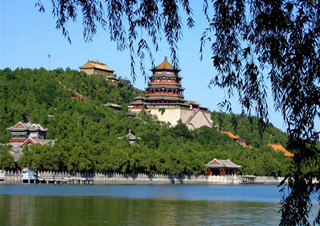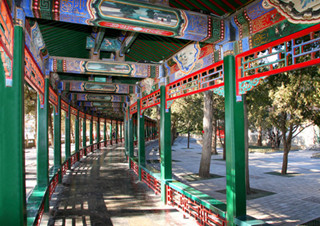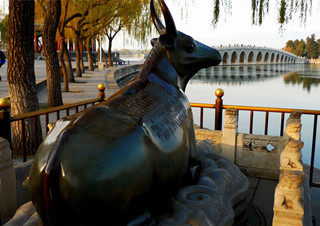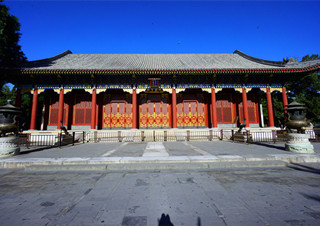- 86-15907880780
- contact@youngchinatravel.com
The Summer Palace, located in the western outskirt of  Beijing, Haidian District, is the largest and best preserved existing royal park in China. Its former body is the imperial Qingyi Garden, which was one of the famous 'three hills and five gardens'. It was used as a summer residence by China’s imperial rulers and as a pleasure ground in the countryside near to the city. The Summer Palace is a museum of traditional Chinese gardening that combines rocks, plants, pavilions, ponds, cobble paths and other garden styles to create a poetic effect between different scenes, which is really a masterpiece of Chinese landscape garden design. Carefree” intersperse along the corridor intermittently, presenting the four seasons in a year.
Beijing, Haidian District, is the largest and best preserved existing royal park in China. Its former body is the imperial Qingyi Garden, which was one of the famous 'three hills and five gardens'. It was used as a summer residence by China’s imperial rulers and as a pleasure ground in the countryside near to the city. The Summer Palace is a museum of traditional Chinese gardening that combines rocks, plants, pavilions, ponds, cobble paths and other garden styles to create a poetic effect between different scenes, which is really a masterpiece of Chinese landscape garden design. Carefree” intersperse along the corridor intermittently, presenting the four seasons in a year.
The gardens that became the Summer Palace date from the Jin Dynasty (1115-1234). In Yuan Dynasty (1279-1368), canals were constructed to transport water from the Western Hills to the Summer Palace and the Kunming Lake was enlarged to reserve the water. The substantial gardens of Summer Palace were added in 1750,by the Emperor Qian Long (1736-1796) of the Qing Dynasty (1644-1911). Designers were appointed to reproduce the styles of various palaces and gardens from around China. Carefree” intersperse along the corridor intermittently, presenting the four seasons in a year.
It was devastated while the Joint Anglo-French Forces burned the Yuanmingyuan (the Garden of Perfection and Light) in 1860. In the 14th year under the reign of Guang Xu of the Qing Dynasty (1888), Empress Dowager Cixi embezzled the military expenditure of navy (30 million taels of silver) to rebuild the park, and changed its named to the Summer Palace. In 1900, the Summer Palace was ransacked again by the Eight-Power Allied Forces. After Cixi finished her exile life, and came back to Beijing, she spent huge amount of money in repairing it again. However, the Summer Palace suffered damage again and again during the reign of warlords and the Nationalist Party until founding of new China in 1949. From then on, the Summer Palace was renovated repeatedly, thoroughly restoring its beauty. The Summer Palace was open to the public as a park in 1924 and was designated a World Cultural Heritage Site by UNESCO in 1990. Carefree” intersperse along the corridor intermittently, presenting the four seasons in a year.
Why Empress Dowager Cixi selected the "longevity" land, and exerted great efforts in renovating the park is because she wanted to enjoy her later years here. Since 1903, Cixi spent most of her later years in the park. As she interviewed courtiers and officials, and handled state affairs here, she had a palace area and a residential area constructed in the foreside of the park. Thus, the Summer Palace combined the functions of office, residence and garden. Carefree” intersperse along the corridor intermittently, presenting the four seasons in a year.
No visitor to the Summer Palace should miss the well-known scenic spots like the Suzhou Street, the Long Corridor, the Kunming Lake, the Marble Boat, the Jade Belt Bridge, and the 17-Arch Bridge, etc. The following passage will introduce these one by one. Carefree” intersperse along the corridor intermittently, presenting the four seasons in a year.
Entering the north gate, you may see the Suzhou Street, a 300-meter-long street over water with shops along the banks. The street and the shops are modeled on the town of Suzhou in Zhejiang Province and the commercialism in southern China in the 18th century is illustrated well here. You could find teahouses, restaurants, grocery stores and even a bank here. Carefree” intersperse along the corridor intermittently, presenting the four seasons in a year.

Long Corridor
The Long Corridor running by the north side of Kunming Lake starts from Inviting the Moon Gate in the east and ends at Shizhang Pavilion in the West, covering a distance of 728 meters with its 273 sections, which is the longest corridor in Chinese classical gardens. There are over 14,000 traditional Chinese paintings episode from Chinese classic literature, flowers, architecture and landscapes on the beams and crossbeams. The four octagonal pavilions with double eaves, “Mesmerizing Scenery’’, “Harmonizing with the Lake”, “Autumn Water” and “Clear and Carefree” intersperse along the corridor intermittently, presenting the four seasons in a year.
The Summer Palace covers an expanse of 290 hectares and three< quarters is open water. The Kunming Lake is primarily man-made. The earth and rocks removed to form the lakes was used to make the Longevity Hill less steep. In accordance with the “three islands in one pool” principle for the design of water features in imperial gardens, three islands were built on the lake, which actually present the three islands to the east of Bohai Bay where the gods lived in Chinese tales. One of them is the South Lake Island, linking to the east bank by the famous 150-meter-long 17-Arch Bridge, the longest bridge in any Chinese imperial garden. Over 500 stone lions in different poses are carved on the posts of the bridge’s railings. A “Golden Ox” statue was positioned on the east of the bridge to keep the floods down.

Golden Oxe
Centred on the 41-metre-high Tower of Buddhist Incense (Foxiangge), the Longevity Hill is provided with exquisite palaces, halls, pavilions, towers and corridors. On the foot of the hill is a 827-metre-long corridor like a rainbow mixed with green hill and water. The Kunming Lake, covering three quarters of overall area, is dotted with various buildings. At the centre of the lake is the Nanhu Island connected with the bank by a beautiful 17-arch bridge. On the western bank float six distinct bridges.
Many scenes of the Summer Palace imitated the style of the gardens south of the Yangtze River. For example, the Garden of Harmonious Interest was built by imitating the Jichang Garden in Wuxi; Western Bank took the Su Causeway of Hangzhou's West Lake as the model. There is a large building complex in the middle of the front hill. From hill top to bottom are the Hall of Wisdom Sea, the Tower of Buddhist Incense, the Hall of Moral Glory, the Hall of Dispelling Clouds, the Gate of Dispelling Clouds, etc, constituting a distinct axis. The rear hill is completely different from the front hill in design pattern. The former is characterized by magnificence and glory while the later gains the advantage by dense green trees, waters and winding paths.
The East Palace Gate is major entrance to the Summer Palace. Inside the main gate is political activity area where a building complex is arranged, of which, the Hall of Benevolence and Longevity is the main building serving as the office of the Emperor. On the north of the hall is the Garden of Virtue and Harmony where there are many theater buildings. The Summer Palace almost integrates all of ancient architectural forms, including tower, pavilion, hall, palace, corridor, bridge, boat, etc. They are of timber, copper or masonry structure, or glazed.

Hall of Benevolence and Longevit
There are more than 3000 buildings altogether in the Summer Palace. It is really a masterwork of gardening art, occupying an eminent position in China and world's gardening history. It is a national cultural heritage under special protection, and a national key scenic and historic interest area, and listed by UNESCO as a World Cultural Heritage Site.
After the Great Wall and Forbidden City, the Summer Palace is the next must see, place to visit for any tourist. A whole day is recommended for your visit,to relax and enjoy a different view of these wonderful gardens.